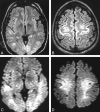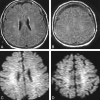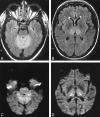MR imaging in comatose survivors of cardiac resuscitation
- PMID: 11559506
- PMCID: PMC7974574
MR imaging in comatose survivors of cardiac resuscitation
Abstract
Background and purpose: The prognosis of comatose survivors is determined by clinical examination. Early laboratory indicators of poor prognosis (such as evoked potentials) have low sensitivity. The role of MR imaging as a confirmatory study was investigated.
Methods: We studied fluid-attenuated inversion recovery (FLAIR) and diffusion-weighted (DW) imaging in 10 patients comatose after cardiac arrest.
Results: None of the 10 comatose patients had myoclonus status epilepticus or fixed, dilated pupils on neurologic examination, and none had abnormal somatosensory-evoked potentials. Eight patients showed diffuse signal abnormalities, predominantly in the cerebellum (n = 5), the thalamus (n = 8), the frontal and parietal cortices (n = 8), and the hippocampus (n = 9). One patient showed normal MR imaging results, and one patient had abnormalities in the thalamus and cerebellum and minimal abnormality on DW images; both later awakened. None of the patients with abnormal cortical structures on FLAIR MR images recovered beyond a severely disabled state.
Conclusion: MR imaging in comatose survivors may parallel the pathologic findings in severe anoxic-ischemic injury, and extensive abnormalities may indicate little to no prospects for recovery. If confirmed, MR imaging may have a role as a prognosticating test in anoxic-ischemic coma.
Figures



Comment in
-
MR imaging in comatose survivors of cardiac resuscitation.AJNR Am J Neuroradiol. 2002 Apr;23(4):738. AJNR Am J Neuroradiol. 2002. PMID: 11950681 Free PMC article. No abstract available.
Similar articles
-
MR imaging in comatose survivors of cardiac resuscitation.AJNR Am J Neuroradiol. 2002 Apr;23(4):738. AJNR Am J Neuroradiol. 2002. PMID: 11950681 Free PMC article. No abstract available.
-
Prognostic value of magnetic resonance imaging in post-resuscitation encephalopathy.Intern Med. 2009;48(18):1635-45. doi: 10.2169/internalmedicine.48.2091. Epub 2009 Sep 15. Intern Med. 2009. PMID: 19755766
-
Efficacy of diffusion-weighted magnetic resonance imaging performed before therapeutic hypothermia in predicting clinical outcome in comatose cardiopulmonary arrest survivors.Resuscitation. 2015 Mar;88:132-7. doi: 10.1016/j.resuscitation.2014.11.031. Epub 2014 Dec 22. Resuscitation. 2015. PMID: 25541428
-
Brain imaging in comatose survivors of cardiac arrest: Pathophysiological correlates and prognostic properties.Resuscitation. 2018 Dec;133:124-136. doi: 10.1016/j.resuscitation.2018.09.012. Epub 2018 Sep 19. Resuscitation. 2018. PMID: 30244045 Review.
-
Clinical neurophysiologic monitoring and brain injury from cardiac arrest.Neurol Clin. 2006 Feb;24(1):89-106. doi: 10.1016/j.ncl.2005.11.003. Neurol Clin. 2006. PMID: 16443132 Review.
Cited by
-
Multi-Center Study of Diffusion-Weighted Imaging in Coma After Cardiac Arrest.Neurocrit Care. 2016 Feb;24(1):82-9. doi: 10.1007/s12028-015-0179-9. Neurocrit Care. 2016. PMID: 26156112
-
Prediction of poor outcome after hypoxic-ischemic brain injury by diffusion-weighted imaging: A systematic review and meta-analysis.PLoS One. 2019 Dec 27;14(12):e0226295. doi: 10.1371/journal.pone.0226295. eCollection 2019. PLoS One. 2019. PMID: 31881032 Free PMC article.
-
MR imaging in comatose survivors of cardiac resuscitation.AJNR Am J Neuroradiol. 2002 Apr;23(4):738. AJNR Am J Neuroradiol. 2002. PMID: 11950681 Free PMC article. No abstract available.
-
Estradiol protects against hippocampal damage and impairments in fear conditioning resulting from transient global ischemia in mice.Brain Res. 2012 Mar 14;1443:64-74. doi: 10.1016/j.brainres.2012.01.014. Epub 2012 Jan 17. Brain Res. 2012. PMID: 22305144 Free PMC article.
-
First autologous cell therapy of cerebral palsy caused by hypoxic-ischemic brain damage in a child after cardiac arrest-individual treatment with cord blood.Case Rep Transplant. 2013;2013:951827. doi: 10.1155/2013/951827. Epub 2013 May 15. Case Rep Transplant. 2013. PMID: 23762741 Free PMC article.
References
-
- Levy DE, Caronna JJ, Singer BH, Lapinski RH, Frydman H, Plum F. Predicting outcome from hypoxic-ischemic coma. JAMA 1985;253:1420-1426 - PubMed
-
- Thomassen A, Wernberg M. Prevalence and prognostic significance of coma after cardiac arrest outside intensive care and coronary units. Acta Anaesthesiol Scand 1979;23:143-148 - PubMed
-
- Mullie A, Verstringe P, Buylaert W, et al. Predictive value of Glasgow coma score for awakening after out-of-hospital cardiac arrest. Cerebral Resuscitation Study Group of the Belgian Society for Intensive Care. Lancet 1988;1:137-140 - PubMed
-
- Sandroni C, Barelli A, Piazza O, Proietti R, Mastria D, Boninsegna R. What is the best test to predict outcome after prolonged cardiac arrest? Eur J Emerg Med 1995;2:33-37 - PubMed
-
- Attia J, Cook DJ. Prognosis in anoxic and traumatic coma. Crit Care Clin 1998;14:497-511 - PubMed
MeSH terms
LinkOut - more resources
Full Text Sources
Medical
